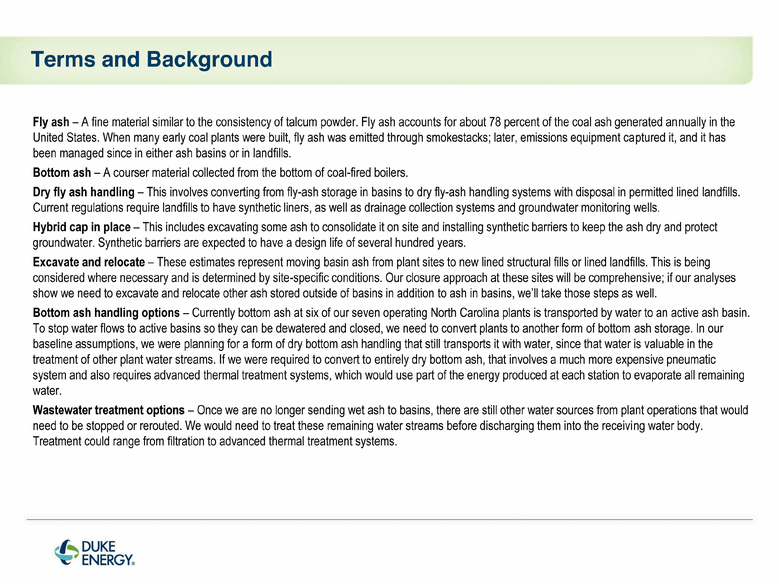Attached files
| file | filename |
|---|---|
| 8-K - 8-K - Duke Energy CORP | a14-10852_48k.htm |
Exhibit 99.1
|
|
$0.0 $1.0 $2.0 $3.0 $4.0 $5.0 $6.0 $7.0 $8.0 $9.0 $10.0 ~$0.5B ~$0.5B $1.0B - $1.5B $4.0B - $5.5B $6.0B - $8.0B The comprehensive, long-term closure strategy to be developed for remaining sites by the end of 2014 will be a site-specific, fact-based approach. $7.0B - $10.0B $2.0B - $2.5B Hybrid cap in place closure at 10 sites not specifically addressed in March 12 Governor's Letter Additional costs associated with Duke's proposal in the March 12 Governor's Letter (Move three sites to new, lined structural fills or landfills; continue Asheville structural fill; convert remaining units to dry fly ash) Dry bottom ash handling & fly ash reliability improvements Increment to excavate to landfills (versus hybrid cap in place) at 10 remaining sites (timeframe 20 to 30 years), pending sitespecific analysis Increment to all-dry pneumatic bottom ash handling systems and thermally-driven evaporation of other process water North Carolina Coal Ash Plan Cost Estimate Comparisons (1) Assumes non-hazardous designation by the US EPA (2) All costs expressed are rough order of magnitude estimates. These are subject to detailed engineering studies and do not include financing, inflation and increased operations and maintenance costs. Duke Energy supports a prudent, environmentally sound, and cost effective solution along this spectrum that addresses both active and retired sites. 1, 2 Baseline Assumption $1.0B - $2.0B $B Full Excavation All-Dry Systems |
|
|
140047-Q4-Earnings-PPT-insidebackground.jpgTerms and Background Fly ash – A fine material similar to the consistency of talcum powder. Fly ash accounts for about 78 percent of the coal ash generated annually in the United States. When many early coal plants were built, fly ash was emitted through smokestacks; later, emissions equipment captured it, and it has been managed since in either ash basins or in landfills. Bottom ash – A courser material collected from the bottom of coal-fired boilers. Dry fly ash handling – This involves converting from fly-ash storage in basins to dry fly-ash handling systems with disposal in permitted lined landfills. Current regulations require landfills to have synthetic liners, as well as drainage collection systems and groundwater monitoring wells. Hybrid cap in place – This includes excavating some ash to consolidate it on site and installing synthetic barriers to keep the ash dry and protect groundwater. Synthetic barriers are expected to have a design life of several hundred years. Excavate and relocate – These estimates represent moving basin ash from plant sites to new lined structural fills or lined landfills. This is being considered where necessary and is determined by site-specific conditions. Our closure approach at these sites will be comprehensive; if our analyses show we need to excavate and relocate other ash stored outside of basins in addition to ash in basins, we’ll take those steps as well. Bottom ash handling options – Currently bottom ash at six of our seven operating North Carolina plants is transported by water to an active ash basin. To stop water flows to active basins so they can be dewatered and closed, we need to convert plants to another form of bottom ash storage. In our baseline assumptions, we were planning for a form of dry bottom ash handling that still transports it with water, since that water is valuable in the treatment of other plant water streams. If we were required to convert to entirely dry bottom ash, that involves a much more expensive pneumatic system and also requires advanced thermal treatment systems, which would use part of the energy produced at each station to evaporate all remaining water. Wastewater treatment options – Once we are no longer sending wet ash to basins, there are still other water sources from plant operations that would need to be stopped or rerouted. We would need to treat these remaining water streams before discharging them into the receiving water body. Treatment could range from filtration to advanced thermal treatment systems. |


